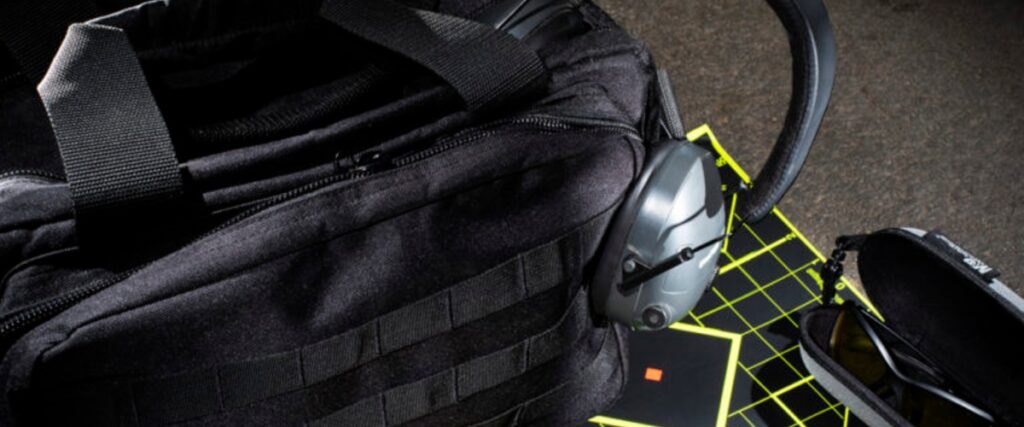
Range bags are an indispensable, yet often overlooked, part of training. They’re designed specifically to carry your firearms, ammo and shooting essentials to the firing line in a single trip. High-quality versions accomplish the task comfortably while keeping your firearms mar free and your gear organized to minimize searching during practice time. If you’re in the market for a new range bag, there are several key considerations, including size, configuration and construction. Invest in the right bag, one well-suited to your individual shooting interests, and it can pay big dividends.
Basic Construction
Rugged build is always first and foremost. Range bags are unceremoniously tossed in vehicle trunks and truck beds, get dragged long distances to the firing line, are sometimes tripped over and occasionally become the resting place for hot brass. Those with a paper-thin outer skin don’t survive the abuse for long. Additionally, lightweight nylon bags may handle a subcompact pistol, but add magazines, ammo, hearing protection and other gear and they can rip, ruining your training session.
Reinforcing at key stress points improves a bag’s longevity. Look for box X stitching at stress points, an industry norm for critical weight-bearing gear. The pattern is unmistakable, with threads making an X inside their square “box.” Some models have polymer “feet” below the bag to prevent friction from wearing through the outer nylon when it’s inevitably dragged. Other models address the problem by doubling the material on the bottom.
Get a Grip
Carry handles are another component to inspect closely. Padding on the handles ensures comfortable carry to the firing line, but it’s not mandatory, particularly if you’re considering a bag just big enough for your concealed-carry firearm and gear. How the handles are attached is crucial. Those stitched onto the top only, with minimal contact area, will be most prone to failure.
High-quality range bags typically feature a pair of padded handles with a solid length of nylon webbing that runs from one handle, down and across the bag’s bottom, rising on the other side to form the second gripping surface. This long-lasting configuration has the added advantage of reinforcing a bag directly below its weight-bearing surface.
If you’re going to carry a large volume of gear, consider a shooting bag with a shoulder strap. Padding here also prevents discomfort—especially important if you’re a competitor required to carry gear from stage to stage during a match. Closely inspect the anchor points as well.
Interior padding protects your valuable firearm during transportation. It’s a bonus if there’s a layer of the material lining the bag’s bottom, which also distributes stress.
There is no limit to the number of different interior configurations available in today’s range bags. Some of the ingredients are ingenious, although opinions vary widely—usually based on the shooter’s favorite discipline.
Size matters when it comes to range bags. Some large versions can carry more than a single handgun and gear to the firing line. The best ones have separate sleeves with padding for each firearm that, when not in use, are removable from the main bag. This offers added protection during transportation and placing one of those sleeves on the shooting bench provides a mar-free surface to rest a pistol between strings of fire. It’s a versatile approach and, in some cases, the pouches can even serve double duty as small range bags. Rifle shooters simply remove them for added bag volume.
Easy-access exterior compartments are a critical component, if for no other reason than comfort. Pouches on the exterior can hold water bottles or other essentials often needed on the firing line. Smaller ones are ideal for pasters, notebooks, pens and other gear. A smartphone storage space is another good touch, particularly for action-shooting sports.
The interior main compartments, or in some cases two mains, need to be large enough to hold everything else. This includes bulky gear such as hearing and eye protection, targets, boxes of ammo, shot timers and more.
Magazines migrate in a big bag and fumbling around to find them costs precious time. Many range bags come with a system of anchoring them down, usually in an exterior compartment to keep them solidly in place and readily available when needed. It takes only a few range sessions to appreciate this amenity.
Velcro Versus Zippers
Velcro patches on the outside allow attaching a patch with your name or special logo to readily identify your bag in the sea of similar versions. It’s a nice touch, although far from mandatory.
Some manufacturers prefer zippers, others Velcro. That again comes down to personal choice. Keep in mind that you can’t padlock nylon hook-and-loop fasteners, but you can lock double-zippered compartments.
There is no single range bag ideal for every shooting enthusiast, despite the fact the key ingredients that go into making one are identical—construction rugged enough to survive, in the right size, with comfort, convenience and looks that appeal to a shooter’s taste. It’s little wonder so many versions are available today.
Let Us Help
Stop by Triangle Shooting Academy today, and our team of firearm experts will be happy to show you our full line of range bags and answer all your questions.
Follow Us
Keep up with the latest updates on our Facebook and Instagram accounts.
